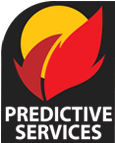Forests and Rangelands Success Story
Predictive Services: Helping Fire Managers Stay Ahead in the Game
U.S. Forest Service Region Six
National Fire Plan - Firefighting

Fire managers have long conferred with National Weather Service Fire Weather Forecasters and tracked National Fire Danger Rating indices to assess the risk of fire ignitions and the possibility that large, damaging fires might occur. While the system has worked well, it relies on a few experienced individuals to make critical decisions. In addition, while fires typically clustered around specific weather events, such as lightning, quantifying expected numbers of fires and the probability that one or more of them would become large fires was difficult. Subsequently, timely and efficient mobilization of firefighting resources was equally difficult. The addition of Predictive Services has provided an important tool in the fire manager’s toolbox.
Conceived in the Pacific Northwest during the late 1990s, and organized in the aftermath of the 2000-Fire Season, Predictive Services has evolved into a national program whose objective is to provide decision-support to fire managers responsible for firefighting resource mobilization and allocation. Located at Geographic Area Coordination Centers around the United States and at the National Interagency Coordination Center (NICC) in Boise, Predictive Services Units are generally comprised of two Fire Weather Meteorologists, a Fire Intelligence Coordinator, and an Intelligence Assistant. Working together, members of the Predictive Services Units collect and analyze historic fire weather, fire danger, and fire occurrence data. Using this information, they paint a canvas on which current and forecasted weather, fire danger, and resource data can be overlain, and from which objective conclusions about fire potential and critical resource needs can be determined out as far as seven days into the future.
"The Predictive Services group provides invaluable information that allows fire managers to make sound decisions based on best science," says Steve Dickenson, the Coordinator, for the Pacific Northwest from 2004 to 2007. This means firefighters can be mobilized to areas of critical fire potential before a fire occurs.
Predictive Services regularly provides a suite of products including the nationally recognized 7-Day Significant Fire Potential forecast along with Monthly (30 days) and Seasonal (90 days) Significant Fire Potential Assessments. Other products and services include forecasts of National Fire Danger Indicators, Fire Activity Forecasts, and in coordination with GIS specialists, a variety of products that spatially display user-defined fire danger and fire weather observations. In coming fire seasons, Predictive Services expects to expand its services to include fire behavior support to incident management teams as they implement a range of fire management responses in accordance with changing fire policies.
Predictive Services works with fire managers and agency administrators to help them make safe, cost-effective, and proactive fire management decisions.
For more information, contact: Dan O’Brien, at d1obrien@blm.gov or 503-808-2733; or, John Saltenberger at John_Saltenberger@blm.gov or at 503-808-2737.